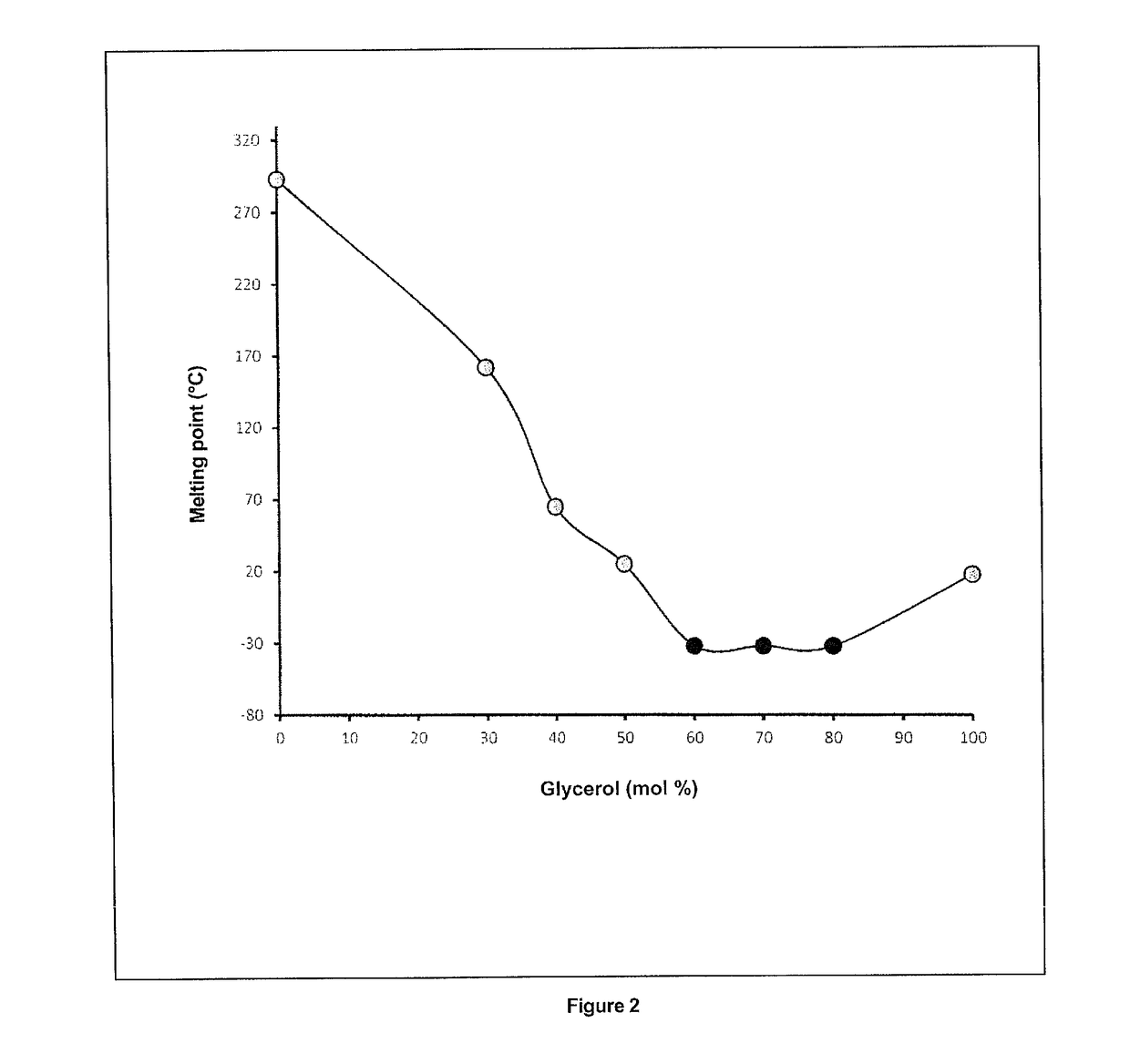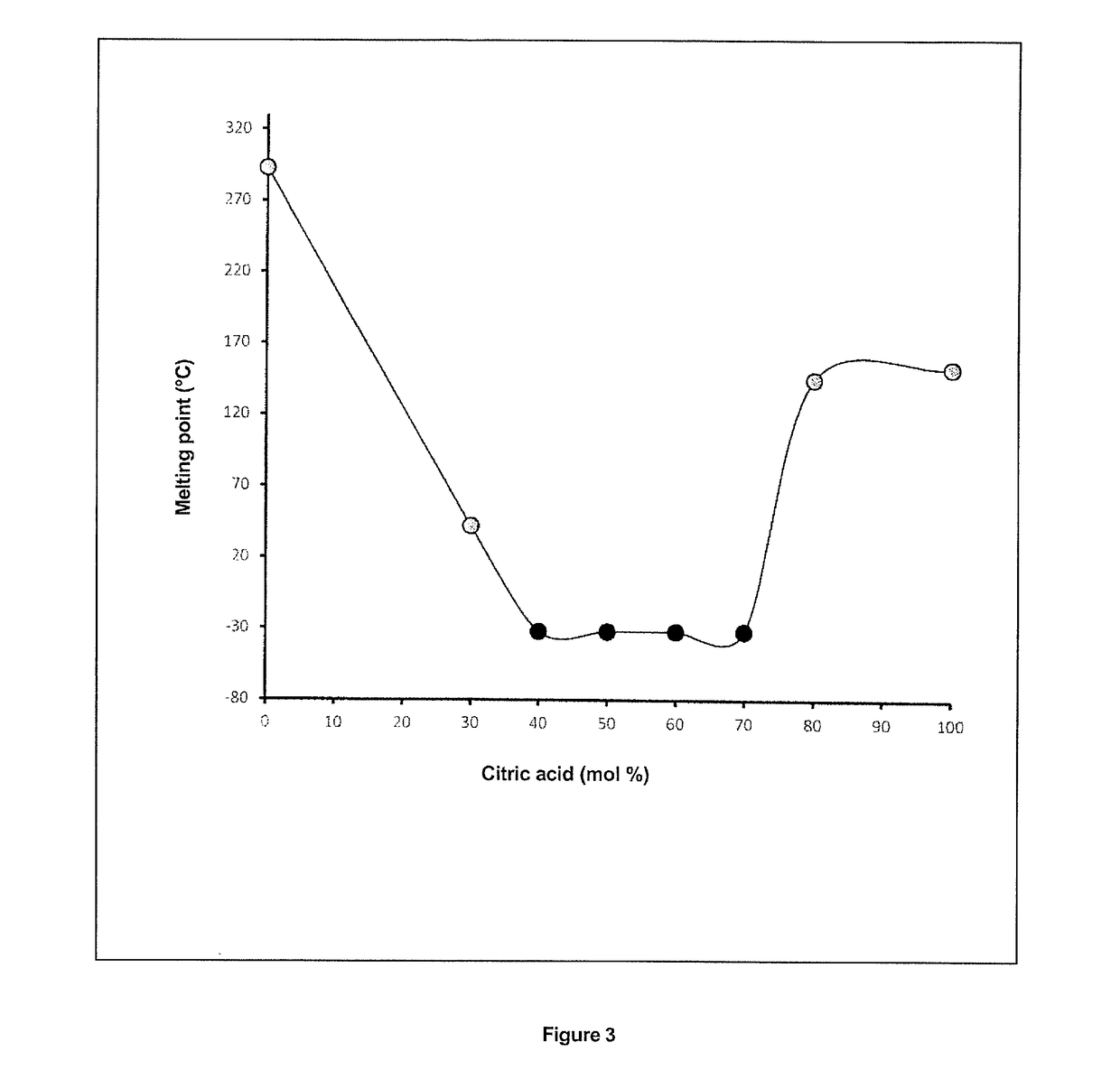Eutectic extraction solvents, extraction methods by eutectigenesis using said solvents, and extracts derived from said extraction methods
- Summary
- Abstract
- Description
- Claims
- Application Information
AI Technical Summary
Benefits of technology
Problems solved by technology
Method used
Image
Examples
example 1
io Criticality of the Betaine:Lactic Acid Binary Mixture
[0181]
TABLE 1Visual appearance of betaine:lactic acidbinary mixtures depending on molar ratioBetaine (%)Lactic acid (%)Clarity7030Immediate formation of a precipitate6040Immediate formation of a precipitate5050Formation of crystals after one week4060Liquid and clear3070Liquid and clear2080Formation of crystals after one day
[0182]When the molar proportions of betaine and lactic acid are varied, a narrow range of composition between 40:60 and 30:70%, respectively, is observed for which the mixture is clear. Below and above this threshold, the mixture exhibits characteristics of unstable media with crystal formation immediately after mixing (betaine:lactic acid molar ratios of 70:30, 60:40 and 50:50) or after one week's storage at ambient temperature (ratio 20:80). It is interesting to note that this composition range corresponds exactly to the appearance of a maximum lowering of the melting point on the phase diagram of the mixtu...
example 2
io Criticality of the Betaine:Glycerol Binary Mixture
[0183]
TABLE 2Visual appearance of betaine:glycerol binarymixtures depending on molar ratioBetaine (%)Glycerol (%)Visual appearance7030Immediate formation of precipitate thencrystallisation6040Immediate formation of precipitate thencrystallisation5050Immediate formation of precipitate thencrystallisation4060Liquid and clear3070Liquid and clear2080Liquid and clear
[0184]Macroscopic observation of betaine:glycerol mixtures with different molar ratios shows that a minimum of 60% glycerol is necessary to obtain a clear mixture which can be used in solid / liquid extraction (Table 2). Betaine:glycerol molar ratios of 70:30, 60:40 and 50:50 all lead to the immediate formation of solid particles visible to the naked eye, which destabilise the medium then rapidly crystallise. These results are also confirmed by the phase diagram of this mixture which indicates a eutectic point for a betaine:glycerol ratio of 40:60 respectively (FIG. 2). The c...
example 3
f Molar Ratio Criticality of the Betaine:Citric Acid Binary Mixture
[0185]
TABLE 3Visual appearance of betaine:citric acid binarymixtures depending on molar ratioBetaine (%)Citric acid (%)Clarity7030Formation of crystals after one week6040Formation of crystals after one week5050Formation of crystals after one week4060Formation of crystals after one week3070Formation of crystals after one week2080Immediate formation of crystals
[0186]Unlike the mixtures described in examples 1 and 2, the betaine:citric acid binary mixtures present no criticality with regard to molar ratio and macroscopic appearance. As can be seen in Table 3, practically all of the composition ranges of the mixture lead to unstable media crystallising after one week. Their use for extraction purposes systematically led to mass setting, either of the mixture alone or of the mixture with the biological material, or even of the liquid extract after filtration. FIG. 3 nevertheless shows that a lowering of the melting point ...
PUM
 Login to View More
Login to View More Abstract
Description
Claims
Application Information
 Login to View More
Login to View More - R&D
- Intellectual Property
- Life Sciences
- Materials
- Tech Scout
- Unparalleled Data Quality
- Higher Quality Content
- 60% Fewer Hallucinations
Browse by: Latest US Patents, China's latest patents, Technical Efficacy Thesaurus, Application Domain, Technology Topic, Popular Technical Reports.
© 2025 PatSnap. All rights reserved.Legal|Privacy policy|Modern Slavery Act Transparency Statement|Sitemap|About US| Contact US: help@patsnap.com



